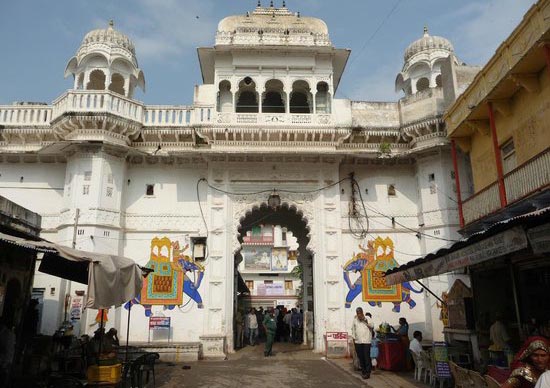Shrinathji Temple

Information of Shrinathji Temple, Nathdwara, Udaipur, Rajasthan
Shrinathji of Nathdwara is considered to be a type of Hindu diety Krishna which has been evident in the form of seven year old child. The main temple of Shrinathji has been in the town of Nathdwara, that is situated 48 kilometers north-east of Udaipur city. Shrinathji is the principal God of the Vaishnava cult who is identified as the Pusthti Marg or the Vallabh Sampradaya developed by Shri Vallabhacharya. Owing to the fame of Shrinathji, Nathdwara town is known as Shrinathji. Most of the people also call it as the bava's nagri. Formerly, the child deity Krishna was called as Devdaman. Later, Shri Vallabhacharya referred him as Gopala and the temple as Gopalpur. After sometime, Vitthal Nathji named this deity as Shrinathji.
Shrinathji Temple Religious Significance
The temple tends to celebrate near about three festivals in a week. In order to take darshan of Shrinathji, the inner sanctum is opened eight times in a day for the devotees. The main attraction of the temple is the Aarti as well as the Shringar which is dressing and beautifying of the idol of God in the temple. The deity is treated as a living child and all the daily normal functions are attended such as taking bath, dressing, offering meals known as Prasad as well as resting times on a regular interval. All these traditions prevailing in the temple tends to demonstrate religious significance for the devotees.
Shrinathji Temple Mythology & History
According to the legends, it is said that the deity of this temple self-manifested from stone and came out from the Govardhan Hills. According to history, it is said that initially the image of Shrinathji was prayed at Govardhan hill which is near Mathura. Originally, the idol of Lord Krishna was transferred from Mathura to Agra in the year 1672 AD in order to prevent it from anti-Hindu iconoclastic Islamic regulations made by the Mughal emperor Aurangzeb. After that, the idol was shifted to a safe place in chariot in order to prevent from barbarian destruction. When the idol reached near a spot named as Sinhad in Mewar, the wheels of the chariot where idol was placed submerged into the mud and did not move any further. The priest then realized the fact that the place was actually the chosen spot of Shrinathji and henceforth the idol was installed in that particular place under the supervision of then Maharaja Raj Singh of Mewar. It is said that during the late 18th century and the early 19th century, the Shrinathji temple was conquered by the Holkars of Indore, the Medas along with the Pindas. Hence, the idol was transferred and protected to a safe place in Udaipur under the support of Maharana Bheem Singh of Mewar.
Shrinathji Temple Architectural Significance
It is said that the main temple at Nathdwara was constructed during the 17th century at the spot that was designed by Shrinathji himself. The temple is known as 'Shrinathji ki Haveli' because of the fact that it has a chariot in order to move God, a store room for milk, betel, sugar and sweetmeats, flowers, jewelry chamber, drawing room and a gold and silver grinding wheel. The idol has been designed out of colossal black marble stone comprising of images of two cows, two peacock, one parrot, one snake and one lion engraved upon it. Shrinathji have been decorated with woven shaneels and silk clothes possessing original zari and embroidery work. The temple has been designed in a 'Haveli style of architecture'.
- Andhra Pradesh Temples
- Assam Temples
- Bihar Temples
- New Delhi Temples
- Goa Temples
- Gujarat Temples
- Jammu and Kashmir Temples
- Karnataka Temples
- Kerala Temples
- Madhya Pradesh Temples
- Maharashtra Temples
- Odisha Temples
- Punjab Temples
- Rajasthan Temples
- Sikkim Temples
- Tamil Nadu Temples
- Telangana Temples
- Uttar Pradesh Temples
- Uttarakhand Temples
- West Bengal Temples